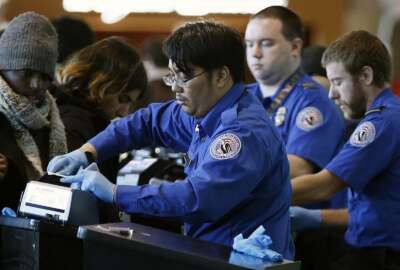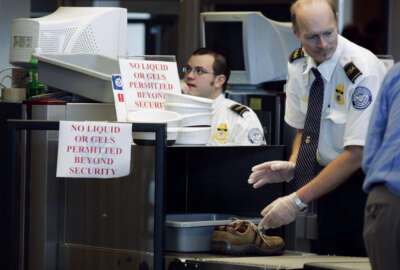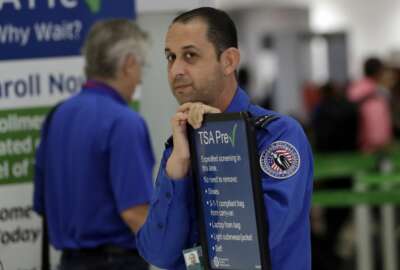TSA launches updated approach to a never-ending program
One thing the Transportation Security Administration (TSA) never stops tinkering with is passenger screening, both techniques and supporting technology. Screening...
One thing the Transportation Security Administration never stops tinkering with is passenger screening both techniques and supporting technology. Now, screening is light years from what it was in the days right after an earlier 9-11. Now it’s published what it calls an open architecture roadmap aimed at improving screening performance. For details on the roadmap and its goals, Federal Drive with Tom Temin spoke to TSA systems engineer Erick Rekstad.
Interview Transcript:
Erick Rekstad Yes, thank you for having me and anxious to have this conversation.
Tom Temin So tell us, what is the open architecture roadmap and what will it actually do? What will it guide TSA in doing next?
Erick Rekstad From open architecture standpoint, I think when people hear that phrase, they have a lot of different ideas on what that means. And so the roadmap itself is really focused on being that foundational document, helping to establish the guiding principles for TSA moving forward and really honing in to where we want to go in the future. We want to get that connected transportation security system. The systems and the methodology that we’re looking towards is that open architecture methodology. And what I mean by that is going towards a standards based approach so that systems are interoperable. Getting to the level where we can build components and then bring those components together to provide ultimately a superior end product and end system. So the roadmap itself is focused on really the what and the why and not diving too much into the how and the when. So what are we going after? We’re going after that connected transportation security system as systems leveraging a standards based approach.
Tom Temin Will this also allow more frequent or more contingent based updates to the systems that might be in place as different threats emerge or you discover, hey, this would shave off 12 milliseconds and that adds up to 10000 hours of screening a year, that type of thing.
Erick Rekstad Exactly. So TSA has a vision to become more of an agile agency. And so moving towards open architecture allows us to leverage all the industry to bring new capability to our screening environment, whether that’s an algorithm developer or a hardware developer, any of those things. So you talk about a new threat emerging. Why work with just one entity to get that? Let’s work with all those software developers, all those people with AI experience machine learning experience to tap into that knowledge and bring new capability to light.
Tom Temin And you mentioned earlier, this is not just about hardware, you know, and changing that out. But TSA does acquire and maintain a huge base of very big pieces of hardware for screening the baggage and screening the people and their junk they carry on with them, like camels. I can’t believe what people carry on nowadays. But you got to look at it all. But I imagine the goal would not to have to be replacing an entire gigantic machine every time there’s an advance in screening technology. But could that machine and the APIs, for example, be standardized such that you could give new life to an old piece of hardware that still runs, the belts still work and the flapper gates, are still in good shape?
Erick Rekstad Yeah, exactly. And you’re hitting on the huge mission space that we have. So we’re trying to handle over 2 million passengers a day at over 430 airports. You mentioned the equipment. We have over 2300 screening lanes and have 50,000 officers running that equipment. And we have to keep that equipment operating. But you think of the complexity that that brings. Our officers have to deal with the variations of those equipment, the buttonology, the different procedures associated with it. Putting all that burden on the shoulders of the officers is not where we want to be. And so taking advantage of open architecture will help us to streamline that experience, allowing that officer to have the same button knowledge regardless of the hardware, and allowing us to tap into different providers of software or hardware. So yeah, to your point, it changes our kind of recapitalization to a method where we have more ownership in that refresh and can continuously be developing and providing capability to the field.
Tom Temin Almost as if the machines had the PNRDL standard that came to transmissions and cars many, many years ago. So no matter what car you drive, the next click is neutral.
Erick Rekstad Exactly.
Tom Temin We’re speaking with Erick Rekstad. He’s a systems engineer at the Transportation Security Administration. And again, this might be putting the cart before the horse a little bit, but doesn’t TSA have an ultimate goal at some point in the grand future of screening without all of the lanes and stuff where people just walk by, maybe an archway they don’t even be aware of and they are screened? I mean, that’s not going to happen next week or next year or maybe not this decade. But does all of this lead toward that kind of ultimate goal, do you think, in the long term?
Erick Rekstad Most definitely. So again, our goal is to get that connected transportation security system systems. We leverage a standards based approach which opens our opportunity to work with multiple industry partners, and that’s in the hardware or software space. So that lends us to the ability to identify what is that new technology, and we can easily integrate it into the future checkpoint system. Where we are right now is that they are completely independent systems requiring us to do a complete replacement of that equipment, complete new training, a new procedures, again, the complexities of the officer. So with the standardization, we bring that back together and allow for that streamlining of capability and ultimately getting to higher security effectiveness, better throughput and the customer experience as well.
Tom Temin Sure. Although the training is not too bad, you get a couple of weeks in Las Vegas when it happens, you know. So but, you know, if you get out of the hotel room very much, it’s hard to tell. And getting to the roadmap document itself, it’s only 28 pages. So it seems like a high level type of thing for standards roadmap. I mean, the Bluetooth standard, you know, would take up 28 pages of fine tape. So what’s in this document and what should industry take from it? Do you think?
Erick Rekstad It’s meant to be foundational? So we tried to keep it short and to the point. It’s not meant to provide all the details of exactly how we’re going to get to the end state or when we’re going to get to the end state. But again, getting to the the what and the why. So what is it that we’re going after and why do we need to go after it? We identified multiple reasons on the why we do had that critical mission to protect the nation’s transportation security system, to ensure freedom of movement for people in commerce with the idea or the vision that we do that in an agile way. And the open architecture roadmap highlights how using standards will get us to there. There are four goals within that roadmap, which touches on some of those key aspects of where we’re trying to go and where complementary activities and documentation will be developed to outline as far as what industries should hear from that, There’s a specific goal to start providing that data pipeline so that we’re providing a wealth of stream of commerce, images, threat images and engaging with all of industry partners to continuously develop new capability likely in the algorithm space. So that we’re not at the let’s just develop it and try to figure out a way to provide it to the field in some time. But every year, every couple of months, we’re refreshing and improving how we’re doing algorithms to provide lower false alarms to improve that customer experience or improving detection as emerging a threat step here.
Tom Temin And someday they’ll be able to squirt a something, a light beam at a bottle and know it’s really suntan lotion and not some kind of horrible substance.
Erick Rekstad Yeah, that’s definitely one of the efforts that we have, is to to improve detection of of liquids and using new technology. And that all plays into to open architecture as you get that sensor information, what can you do with that? And so moving away from just one vendor’s opinion on how or way of doing that we can tap into, let’s take that sensor information off the machine and use it in any way we possibly can. So tap into those great minds again in artificial intelligence, machine learning that they may be able to use that information differently than our legacy vendors can.
Tom Temin And just a final question. There is an external group, not external to DHS, but external to TSA, and that is the Transportation security lab that actually verifies what vendors and industry say they’ve got before and testing it before it goes over to operational deployment to TSA. Were they part of this open architecture thinking too, the lab?
Erick Rekstad Yeah. So there’s multiple parts that one is we do have a specific goal and the open architecture roadmap that talks about we have to evaluate policies, processes, products like organizationally this is going to change how we do business. One of the things we highlight is it’s going to change how we do testing. Historically, we’ve tested a box, so a single solution by one provider, which includes hardware, software and that gets certified. Now we’re talking about components. And so breaking up those components and putting them together and different configurations having to certify that. So we actually engaged with DHS S&T early on this and have been partnering with them continuously. We actually had an industry day last week with them in partnership at TSA headquarters, where we brought in nearly 200 participants from industry to talk about how this is to change the certification process specifically when you look at machine learning and open architecture.
Tom Temin All right, so you’ve got some work cut out then for the next few years, really.
Erick Rekstad Most definitely. We outlined in the roadmap itself just some high level goals and a pathway of sort of measures of success for the next two years. But we will be diving deep into all the ways that we can bring open architecture to reality and bring that capability to the field and improve that customer experience.
Copyright © 2025 Federal News Network. All rights reserved. This website is not intended for users located within the European Economic Area.
Tom Temin is host of the Federal Drive and has been providing insight on federal technology and management issues for more than 30 years.
Follow @tteminWFED






